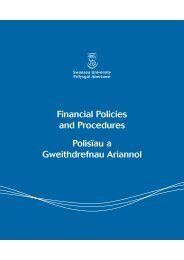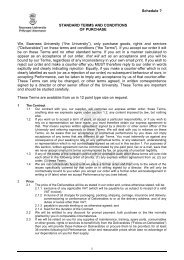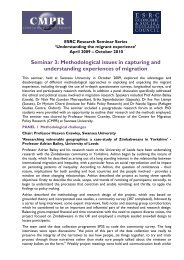in the Labrador Sea region - Swansea University
in the Labrador Sea region - Swansea University
in the Labrador Sea region - Swansea University
Create successful ePaper yourself
Turn your PDF publications into a flip-book with our unique Google optimized e-Paper software.
Terrestrial climate signal of <strong>the</strong> “8200 yr B.P. cold event” <strong>in</strong> <strong>the</strong><br />
<strong>Labrador</strong> <strong>Sea</strong> <strong>region</strong><br />
Timothy J. Daley 1,2* , F. Alayne Street-Perrott 1 , Neil J. Loader 1 , Keith E. Barber 2 , Paul D.M. Hughes 2 , Elizabeth H. Fisher 3 ,<br />
and James D. Marshall 3<br />
1<br />
School of <strong>the</strong> Environment and Society, <strong>Swansea</strong> <strong>University</strong>, <strong>Swansea</strong> SA2 8PP, UK<br />
2<br />
Palaeoecology Laboratory (PLUS), School of Geography, <strong>University</strong> of Southampton, Southampton SO17 1BJ, UK<br />
3<br />
Department of Earth and Ocean Sciences, <strong>University</strong> of Liverpool, Liverpool L69 3GP, UK<br />
ABSTRACT<br />
Accelerated melt<strong>in</strong>g of Greenland ice has raised concern about<br />
<strong>the</strong> future impact of enhanced freshwater discharge on <strong>region</strong>al<br />
climate through its effect on ocean circulation. An abrupt cool<strong>in</strong>g<br />
event ca. 8200 cal. yr B.P. has been l<strong>in</strong>ked to meltwater from<br />
<strong>the</strong> decay<strong>in</strong>g North American ice sheet. Oxygen isotopic analyses<br />
of cellulose from subfossil Sphagnum mosses, isolated from a Newfoundland<br />
peat core, reveal a pronounced anomaly ca. 8350 yr B.P.<br />
with a duration of ~150 years. The maximum estimated δ 18 O precipitation<br />
change, 4.53‰ ± 1.05‰ (Vienna standard mean ocean water), is <strong>the</strong><br />
largest observed <strong>in</strong> <strong>the</strong> circum-North Atlantic <strong>region</strong>. The magnitude<br />
of change exceeds that predicted by recent paleoclimate simulations.<br />
Comparisons with recent records of surface and deep ocean<br />
proxies <strong>in</strong> <strong>the</strong> <strong>Labrador</strong> <strong>Sea</strong> and <strong>the</strong> wider North Atlantic <strong>region</strong><br />
suggest synchroneity. However, an ~200 year delay between <strong>the</strong><br />
responses of <strong>the</strong> <strong>Labrador</strong> <strong>Sea</strong> <strong>region</strong> and <strong>the</strong> Greenland Ice Sheet<br />
to <strong>the</strong> effects of meltwater release rema<strong>in</strong>s to be expla<strong>in</strong>ed.<br />
INTRODUCTION<br />
The largest climatic event recorded <strong>in</strong> <strong>the</strong> Nor<strong>the</strong>rn Hemisphere dur<strong>in</strong>g<br />
<strong>the</strong> past 10 ka (Alley et al., 1997; Klitgaard-Kristensen et al., 1998; von<br />
Grafenste<strong>in</strong> et al., 1998) has been attributed to an outburst of meltwater<br />
from glacial Lake Agassiz, 8470 ± 270 years ago (Barber et al., 1999),<br />
with a discharge of ~5.2 Sv (1 Sv = 10 6 m 3 s –1 ) over ~1 year (Teller et al.,<br />
2002; Clarke et al., 2004). In <strong>the</strong> western <strong>Labrador</strong> <strong>Sea</strong>, this megaflood is<br />
represented by a double layer of carbonate-rich turbidites, dated between<br />
ca. 8500 and ca. 8350 yr B.P. (Hillaire-Marcel et al., 2007). It was followed<br />
by a susta<strong>in</strong>ed <strong>in</strong>crease <strong>in</strong> meltwater flux through <strong>the</strong> Hudson Strait (Teller<br />
et al., 2002; Clarke et al., 2004) that created a freshwater anomaly sufficiently<br />
large to slow <strong>the</strong> Meridional Overturn<strong>in</strong>g Circulation of <strong>the</strong> Atlantic<br />
Ocean (AMOC) (Renssen et al., 2001; Wiersma and Renssen, 2006), and<br />
resulted <strong>in</strong> an abrupt cool<strong>in</strong>g of <strong>the</strong> circum-North Atlantic <strong>region</strong> (Klitgaard-Kristensen<br />
et al., 1998; von Grafenste<strong>in</strong> et al., 1998; Rohl<strong>in</strong>g and<br />
Pälike, 2005; Thomas et al., 2007; Marshall et al., 2007). An <strong>in</strong>creas<strong>in</strong>g<br />
meltwater flux from <strong>the</strong> Greenland Ice Sheet (Chen et al., 2006) <strong>in</strong>to <strong>the</strong><br />
Nordic and <strong>Labrador</strong> <strong>Sea</strong>s dur<strong>in</strong>g <strong>the</strong> twenty-first century could potentially<br />
impede deep convection and northward heat transport by <strong>the</strong> AMOC<br />
(Intergovernmental Panel on Climate Change, 2007). The “8200 yr B.P.”<br />
event, <strong>the</strong>refore, provides a means of validat<strong>in</strong>g <strong>the</strong> response of numerical<br />
climate models to a large meltwater perturbation (Alley and Ágústsdóttir,<br />
2005; Wiersma and Renssen, 2006; LeGrande et al., 2006). While significant<br />
cool<strong>in</strong>g at that time has been reported from Europe and Greenland<br />
(Alley et al., 1997; Klitgaard-Kristensen et al., 1998; von Grafenste<strong>in</strong> et al.,<br />
1998; Thomas et al., 2007; Marshall et al., 2007), quantitative estimates of<br />
change from nor<strong>the</strong>astern North America are scarce. Paleoecological data<br />
from peat cores have traditionally been used to reconstruct past moisture<br />
balance (Barber et al., 1998; Hughes et al., 2006). Here we use a novel<br />
extraction method to derive estimates of variation <strong>in</strong> <strong>the</strong> oxygen isotopic<br />
composition of precipitation over nor<strong>the</strong>astern North America from analyses<br />
of <strong>the</strong> cellulose fraction of subfossil Sphagnum leaves. These results<br />
*E-mail: t.j.daley@swansea.ac.uk.<br />
challenge present understand<strong>in</strong>g of <strong>the</strong> climatic sensitivity of this <strong>region</strong> to<br />
<strong>the</strong> postulated forc<strong>in</strong>g mechanisms for <strong>the</strong> 8200 yr B.P. event.<br />
SITE SETTING AND THE ADVANTAGES OF SPHAGNUM<br />
Nordans Pond Bog is a precipitation-fed mire located 1.5 km <strong>in</strong>land<br />
from <strong>the</strong> present-day Atlantic coast of Newfoundland (49.150°N, 53.583°W;<br />
60 m altitude) (Fig. 1). Excellent Sphagnum preservation throughout <strong>the</strong><br />
8700 year period captured <strong>in</strong> peat core NDN02/1, taken from <strong>the</strong> center<br />
of <strong>the</strong> mire, allowed us to construct a Sphagnum-specific time series of<br />
isotopic variations. Sphagnum moss is an excellent <strong>in</strong>dicator of <strong>the</strong> isotopic<br />
composition of grow<strong>in</strong>g-season precipitation, ow<strong>in</strong>g to <strong>the</strong> simplicity of <strong>the</strong><br />
pathway by which it <strong>in</strong>corporates meteoric water <strong>in</strong>to cellulose. Given its<br />
lack of roots and function<strong>in</strong>g guard cells, all fractionation of <strong>the</strong> plant water<br />
is environmentally controlled prior to assimilation and cellulose syn<strong>the</strong>sis<br />
(Ménot-Combes et al., 2002). Isotopic fractionation dur<strong>in</strong>g cellulose syn<strong>the</strong>sis<br />
is <strong>in</strong>dependent of temperature (DeNiro and Epste<strong>in</strong>, 1979; Sternberg<br />
et al., 1986). Previous studies have reported <strong>the</strong> preservation of an evaporative-enrichment<br />
signal <strong>in</strong> <strong>the</strong> cellulose of surface Sphagnum relative to peat<br />
pore waters, based on samples collected on a s<strong>in</strong>gle day or month dur<strong>in</strong>g<br />
summer months (Brenn<strong>in</strong>kmeijer et al., 1982; Aravena and Warner, 1992).<br />
Subsequent isotopic analyses of surface samples of Sphagnum moss, modern<br />
precipitation, and modern bog waters taken regularly throughout an<br />
70ºN<br />
60ºN<br />
NGRIP1<br />
Goose Bay<br />
Ocean<br />
50ºN<br />
Nordans<br />
Pond Bog<br />
Truro<br />
50ºW<br />
MD03-2665<br />
L.C.<br />
E.G.C.<br />
L.C.<br />
40ºW<br />
GRIP<br />
GREENLAND<br />
North<br />
Atlantic<br />
G.S.<br />
I.C.<br />
E.G.C.<br />
MD99-<br />
2251<br />
N.A.D.<br />
0 km 1500<br />
Figure 1. Map of northwest Atlantic <strong>region</strong> show<strong>in</strong>g modern oceansurface<br />
currents, glacial Lake Agassiz outflow, and site locations.<br />
Also shown are core locations (solid circles), Global Network of Isotopes<br />
<strong>in</strong> Precipitation (GNIP) (International Atomic Energy Agency–<br />
World Meteorological Organization, 2004) monitor<strong>in</strong>g stations at<br />
Goose Bay, <strong>Labrador</strong>, and Truro, Nova Scotia (open circles), modern<br />
ocean-surface currents (dark l<strong>in</strong>es—warm currents, gray l<strong>in</strong>es—cold<br />
currents, L.C.—<strong>Labrador</strong> Current, G.S.—Gulf Stream, N.A.D.—North<br />
Atlantic Drift, E.G.C.—East Greenland Current, I.C.—Irm<strong>in</strong>ger Current),<br />
and rout<strong>in</strong>g of f<strong>in</strong>al dra<strong>in</strong>age from glacial Lake Agassiz ca. 8470<br />
years ago (Barber et al., 1999) (thick gray arrow). GRIP—Greenland<br />
Ice Core Project; NGRIP—North Greenland Ice Core Project.<br />
30ºW<br />
© 2009 Geological Society of America. For permission to copy, contact Copyright Permissions, GSA, or edit<strong>in</strong>g@geosociety.org.<br />
GEOLOGY, Geology, September 2009; 2009 v. 37; no. 9; p. 831–834; doi: 10.1130/G30043A.1; 4 figures; Data Repository item 2009203.<br />
831
entire year have revealed that such evaporative effects are not ma<strong>in</strong>ta<strong>in</strong>ed<br />
(Daley, 2007). Instead, <strong>the</strong>se analyses yielded a constant cellulose-precipitation<br />
fractionation factor (1.0274 ± 0.0010; Daley, 2007), statistically<br />
identical to <strong>the</strong> biochemical enrichment of oxygen isotopes dur<strong>in</strong>g photosyn<strong>the</strong>sis<br />
as determ<strong>in</strong>ed by laboratory experiments (Sternberg et al., 1986).<br />
While we cannot exclude entirely <strong>the</strong> possibility that leaf water <strong>in</strong> Sphagnum<br />
is subject to some evaporative enrichment prior to cellulose syn<strong>the</strong>sis,<br />
<strong>the</strong> data reported by Daley (2007) suggest that it is m<strong>in</strong>imal. Measured<br />
δ 18 O and δD of summer bog-surface water samples from Nordans Pond<br />
Bog (n = 8) are with<strong>in</strong> <strong>the</strong> scatter of <strong>region</strong>al precipitation values, show<strong>in</strong>g<br />
that <strong>the</strong> isotopic impact of evaporation at this site is negligible (Fig. 2A).<br />
Fur<strong>the</strong>rmore, <strong>in</strong> <strong>the</strong> modern day, δ 18 O values of precipitation (δ 18 O precipitation<br />
)<br />
are strongly and consistently related to air temperature across <strong>the</strong> Atlantic<br />
prov<strong>in</strong>ces of Canada (Fig. 2B).<br />
δD (‰)<br />
0<br />
-50<br />
-100<br />
Goose Bay Autumn<br />
Truro Autumn<br />
Goose Bay Spr<strong>in</strong>g<br />
Truro Spr<strong>in</strong>g<br />
Goose Bay Summer<br />
Truro Summer<br />
Goose Bay W<strong>in</strong>ter<br />
Truro W<strong>in</strong>ter<br />
Bog waters - June 2004<br />
A<br />
The east coast of Newfoundland is proximal to <strong>the</strong> hypo<strong>the</strong>sized route<br />
of meltwater from glacial Lake Agassiz through <strong>the</strong> Hudson Strait and <strong>the</strong><br />
western <strong>Labrador</strong> <strong>Sea</strong> (Keigw<strong>in</strong> et al., 2005). It also is close to <strong>the</strong> oceanic<br />
surface front between subarctic waters flow<strong>in</strong>g south from <strong>the</strong> <strong>Labrador</strong><br />
<strong>Sea</strong> and <strong>the</strong> warm waters of <strong>the</strong> Gulf Stream (Fig. 1) (M<strong>in</strong>obe et al., 2008).<br />
Recent model simulations predict <strong>the</strong> greatest response of surface air temperature<br />
(SAT) to meltwater forc<strong>in</strong>g <strong>in</strong> <strong>the</strong> area overly<strong>in</strong>g Newfoundland<br />
and <strong>the</strong> sou<strong>the</strong>rn <strong>Labrador</strong> <strong>Sea</strong> <strong>region</strong> (LeGrande et al., 2006). Nordans<br />
Pond Bog, <strong>the</strong>refore, is an ideally located, sensitive archive for track<strong>in</strong>g<br />
atmospheric variations forced by past changes <strong>in</strong> ocean circulation.<br />
NEWFOUNDLAND RECORD<br />
We measured 23 accelerator mass spectrometer (AMS) 14 C ages on<br />
Newfoundland core NDN02/1. A cubic polynomial age-depth model provides<br />
a good fit to <strong>the</strong> distribution of dates (r 2 = 0.996; Fig. DR1 and Methods<br />
<strong>in</strong> <strong>the</strong> GSA Data Repository 1 ). The accumulation rate varies from ~5<br />
a/cm (2 mm/a) <strong>in</strong> <strong>the</strong> base of <strong>the</strong> core to ~17 a/cm (0.6 mm/a) through <strong>the</strong><br />
central section of <strong>the</strong> core.<br />
The δ 18 O precipitation<br />
values estimated from <strong>the</strong> δ 18 O Sphagnum<br />
record of<br />
core NDN02/1 (Data Repository) exhibit an abrupt isotopic decrease<br />
<strong>in</strong> <strong>the</strong> early Holocene, followed by higher values from ca. 7000 to<br />
4000 yr B.P. (Fig. 3). Lower average values of δ 18 O precipitation<br />
, with considerable<br />
superimposed centennial-scale variability, were registered from<br />
ca. 4000 yr B.P. to present.<br />
Air temperature (ºC)<br />
-150<br />
-200<br />
30<br />
20<br />
10<br />
0<br />
-10<br />
-20<br />
-30 -25 -20 -15 -10 -5 0<br />
Goose Bay, <strong>Labrador</strong><br />
y = 2.284x + 35<br />
δ 18 O (‰)<br />
-30<br />
-30 -25 -20 -15 -10 -5 0<br />
δ 18 O precipitation (‰)<br />
Truro, Nova Scotia<br />
y = 2.283x + 28<br />
Figure 2. Modern isotopic and climate data from Global Network<br />
of Isotopes <strong>in</strong> Precipitation (GNIP) [International Atomic Energy<br />
Agency–World Meteorological Organization (IAEA/WMO), 2004] stations<br />
at Goose Bay, <strong>Labrador</strong>, and Truro, Nova Scotia. A: Variation<br />
<strong>in</strong> isotopic composition of meteoric waters by season. Open symbols—Truro.<br />
Closed symbols—Goose Bay. Samples of bog-surface<br />
water taken <strong>in</strong> June 2004 are overlaid as <strong>in</strong>verted gray triangles. B:<br />
Monthly air-temperature (T) values and oxygen isotopic composition<br />
of monthly precipitation (IAEA/WMO, 2004). Open circles—Truro.<br />
Closed circles—Goose Bay. L<strong>in</strong>ear regressions of <strong>the</strong>se data generate<br />
slopes, with 95% confidence band<strong>in</strong>gs (dashed l<strong>in</strong>es), for both<br />
stations that are identical to with<strong>in</strong> 0.001. R 2 values for Goose Bay<br />
and Truro are 0.62 and 0.60, respectively (p < 0.0001). Slope is used<br />
to def<strong>in</strong>e a ΔT – Δδ 18 O precipitation<br />
relationship for <strong>the</strong> Atlantic prov<strong>in</strong>ces<br />
of Canada. Data are expressed as per mil deviations from Vienna<br />
standard mean ocean water.<br />
B<br />
18 Oprecipitation (‰)<br />
δ<br />
-4<br />
-5<br />
-6<br />
-7<br />
-8<br />
-9<br />
-10<br />
0 1000 2000 3000 4000 5000 6000 7000 8000 9000<br />
Age (cal. yr B.P.)<br />
Figure 3. δ 18 O precipitation<br />
reconstructed from δ 18 O Sphagnum<br />
values of core<br />
samples from NDN02/1. Precipitation estimates were derived us<strong>in</strong>g<br />
measured cellulose-water enrichment factor α = 1.0274 ± 0.0010<br />
(Daley, 2007).<br />
Closer exam<strong>in</strong>ation of <strong>the</strong> large negative excursion <strong>in</strong> δ 18 O precipitation<br />
dur<strong>in</strong>g <strong>the</strong> early Holocene reveals a complex paleoclimate signal. A primary<br />
isotopic decl<strong>in</strong>e beg<strong>in</strong>n<strong>in</strong>g ca. 8450 ± 90 yr B.P. was followed by<br />
a smaller negative excursion ~200 years later (Fig. 4). From higher than<br />
modern values before 8450 ± 90 yr B.P., δ 18 O precipitation<br />
fell abruptly by 3‰<br />
<strong>in</strong> ≤55 years. The isotopic m<strong>in</strong>imum was centered on 8350 ± 90 yr B.P.,<br />
represent<strong>in</strong>g a total decrease of 4.53‰ <strong>in</strong> ~100 years. As def<strong>in</strong>ed by <strong>the</strong><br />
midpo<strong>in</strong>ts of <strong>the</strong> ris<strong>in</strong>g and fall<strong>in</strong>g limbs, <strong>the</strong> duration of <strong>the</strong> primary anomaly<br />
was ~150 years. A rapid recovery to δ 18 O precipitation<br />
values similar to <strong>the</strong><br />
average for <strong>the</strong> past 4 ka preceded a smaller, secondary, negative excursion<br />
with an amplitude of just under 2‰, beg<strong>in</strong>n<strong>in</strong>g at 8250 ± 90 yr B.P. and<br />
culm<strong>in</strong>at<strong>in</strong>g at 8170 ± 90 yr B.P. Recovery to values similar to those of <strong>the</strong><br />
mid- to late Holocene average was complete by ca. 8060 ± 110 yr B.P.,<br />
giv<strong>in</strong>g a total duration for <strong>the</strong> secondary isotopic excursion of ~200 years.<br />
A gap <strong>in</strong> <strong>the</strong> record follows due to <strong>the</strong> disappearance of Sphagnum taxa,<br />
although three coregistered biological and physical proxies from <strong>the</strong> core<br />
<strong>in</strong>dicate that warmer conditions prevailed (Hughes et al., 2006).<br />
1<br />
GSA Data Repository item 2009203, methods and chronology, is available<br />
onl<strong>in</strong>e at www.geosociety.org/pubs/ft2009.htm, or on request from edit<strong>in</strong>g@geosociety.org<br />
or Documents Secretary, GSA, P.O. Box 9140, Boulder, CO 80301, USA.<br />
832 GEOLOGY, September 2009
A<br />
B<br />
C<br />
D<br />
E<br />
δ 18 O precipitation<br />
(‰ VSMOW)<br />
% N. pachyderma (s)<br />
(Ellison et al., 2006)<br />
C. wuellerstorfi<br />
δ 13 C (‰ VPDB)<br />
(Kleiven et al., 2008)<br />
F<br />
-4<br />
-6<br />
-8<br />
-10<br />
Age (cal. yr B.P.)<br />
7600 7800 8000 8200 8400 8600 8800 9000<br />
0<br />
1<br />
2<br />
3<br />
4<br />
5<br />
6<br />
7<br />
1.5<br />
1.0<br />
0.5<br />
0.0<br />
-0.5<br />
MD99-2251<br />
MD03-2665<br />
Term<strong>in</strong>al outburst of<br />
glacial Lake Agassiz<br />
-37<br />
7600 7800 8000 8200 8400 8600 8800 9000<br />
Age (cal. yr B.P.) GICC05<br />
NDN02/1<br />
HWLC1<br />
MD03-2665<br />
GRIP and NGRIP<br />
δ 18 O ice (‰)<br />
INTERPRETATION OF THE STABLE ISOTOPE RECORD<br />
Comparison of <strong>the</strong> estimated values of δ 18 O precipitation<br />
with measured<br />
modern δ 18 O precipitation<br />
and temperature data from <strong>the</strong> Global Network for<br />
Isotopes <strong>in</strong> Precipitation (GNIP; International Atomic Energy Agency–<br />
World Meteorological Organization, 2004) site at Truro, Nova Scotia<br />
-5.0<br />
-5.2<br />
-5.4<br />
-5.6<br />
-5.8<br />
-6.0<br />
-6.2<br />
-6.4<br />
-6.6<br />
2.0<br />
2.2<br />
2.4<br />
2.6<br />
-33<br />
-34<br />
-35<br />
-36<br />
δ 18 O c (‰ VPDB)<br />
(Marshall et al., 2007)<br />
N. pachyderma (s)<br />
δ 18 O (‰ VPDB)<br />
(Kleiven et al., 2008)<br />
Isotopically<br />
depleted<br />
precipitation/<br />
cooler<br />
surface air<br />
temperatures<br />
Cooler SSTs<br />
Reduced<br />
LNADW<br />
Figure 4. Atmospheric response over Newfoundland compared with<br />
terrestrial record from nor<strong>the</strong>rn England, records of surface and<br />
deep ocean variability from <strong>Labrador</strong> <strong>Sea</strong> and North Atlantic, and<br />
oxygen isotopic records from Greenland. A: δ 18 O precipitation reconstruction<br />
from core NDN02/1. Error bars show 2σ calibrated range from<br />
accelerator mass spectrometry 14 C dates bracket<strong>in</strong>g primary isotopic<br />
event. B: Oxygen isotopic variation <strong>in</strong> lake-sediment calcite from<br />
Hawes Water, nor<strong>the</strong>rn England (Marshall et al., 2007). C: Variation<br />
<strong>in</strong> percent Neogloboquadr<strong>in</strong>a pachyderma (s) <strong>in</strong> ocean core MD99–<br />
2251, south of Iceland (Ellison et al., 2006). D: Variation <strong>in</strong> oxygen<br />
isotopic composition of N. pachyderma (s) <strong>in</strong> core MD03–2665 from<br />
<strong>the</strong> Eirik Drift (Kleiven et al., 2008). E: Benthic Cibicidoides wuellerstorfi<br />
δ 13 C values from core MD03–2665 (Kleiven et al., 2008). F: Two<br />
recently synchronized δ 18 O ice<br />
records from Greenland ice cores GRIP<br />
(dashed l<strong>in</strong>e) and NGRIP1 (V<strong>in</strong><strong>the</strong>r et al., 2006; Rasmussen et al.,<br />
2006) cover<strong>in</strong>g period 9000–7600 yr B.P. Chronological uncerta<strong>in</strong>ty<br />
<strong>in</strong> F assumes layer-count<strong>in</strong>g error of 47 years throughout this time<br />
period (V<strong>in</strong><strong>the</strong>r et al., 2006). SST—sea surface temperature; GRIP—<br />
Greenland Ice Core Project; NGRIP—North Greenland Ice Core Project;<br />
VSMOW—Vienna standard mean ocean water; VPDB—Vienna<br />
Peedee belemnite; LNADW—Lower North Atlantic Deep Water.<br />
(Fig. 2A), suggests that dur<strong>in</strong>g <strong>the</strong> primary anomaly, SATs dur<strong>in</strong>g <strong>the</strong><br />
Sphagnum grow<strong>in</strong>g season cooled from values warmer than modern Nova<br />
Scotian summers to ones more similar to Nova Scotian autumn or early<br />
spr<strong>in</strong>g. If <strong>the</strong> modern temperature-isotope relationship for <strong>the</strong> Atlantic<br />
prov<strong>in</strong>ces of Canada, ΔT = 2.284(Δδ 18 O precipitation<br />
), is applied (Fig. 2B), <strong>the</strong><br />
apparent cool<strong>in</strong>g dur<strong>in</strong>g <strong>the</strong> primary anomaly was ~10.3 °C. This implausibly<br />
large estimate must be corrected for <strong>the</strong> reduction <strong>in</strong> δ 18 O values<br />
of surface ocean water <strong>in</strong> <strong>the</strong> moisture source <strong>region</strong> by <strong>the</strong> meltwater<br />
released from Lake Agassiz, which may reduce its magnitude significantly.<br />
However, we are not aware of any suitably located mar<strong>in</strong>e cores<br />
with sufficient temporal resolution to calculate <strong>the</strong> maximum isotope<br />
anomaly and its subsequent evolution through time. Numerical model<strong>in</strong>g<br />
studies (W<strong>in</strong>sor et al., 2005; LeGrande et al., 2006) suggest that <strong>the</strong> meltwater<br />
plume passed <strong>the</strong> study site and mixed throughout <strong>the</strong> wider North<br />
Atlantic with<strong>in</strong> ~10–20 years, imply<strong>in</strong>g that <strong>the</strong> δ 18 O precipitation<br />
anomaly<br />
observed <strong>in</strong> NDN02/1 primarily reflects a centennial-scale change <strong>in</strong> <strong>the</strong><br />
<strong>the</strong>rmal gradient between <strong>the</strong> moisture source and <strong>the</strong> site of precipitation<br />
and/or a change <strong>in</strong> <strong>the</strong> prevail<strong>in</strong>g orig<strong>in</strong> of that moisture (a change <strong>in</strong> <strong>the</strong><br />
modern ΔT/Δδ 18 O precipitation<br />
relationship).<br />
Strong atmospheric cool<strong>in</strong>g and decreased δ 18 O precipitation<br />
values over<br />
<strong>the</strong> study area were observed <strong>in</strong> simulations of <strong>the</strong> climate response to<br />
catastrophic dra<strong>in</strong>age of glacial Lake Agassiz (Wiersma and Renssen,<br />
2006; LeGrande et al., 2006). The most pronounced response of both<br />
δ 18 O precipitation<br />
and surface air temperature was found over <strong>the</strong> <strong>Labrador</strong> <strong>Sea</strong><br />
south of Greenland and nor<strong>the</strong>rn Newfoundland (LeGrande et al., 2006).<br />
However, <strong>the</strong> maximum isotopic change recorded <strong>in</strong> NDN02/1 exceeds<br />
that simulated by numerical models (Renssen et al., 2001; Wiersma and<br />
Renssen, 2006; LeGrande et al., 2006). Moreover, modeled decadal-average<br />
changes consistently underestimate those observed <strong>in</strong> paleoclimate<br />
records around <strong>the</strong> North Atlantic <strong>region</strong> (LeGrande et al., 2006).<br />
The complexity of <strong>the</strong> terrestrial climate record <strong>in</strong> Newfoundland<br />
dur<strong>in</strong>g <strong>the</strong> period ca. 8500 to ca. 8000 yr B.P. is attested to by <strong>the</strong> presence<br />
of <strong>the</strong> secondary isotopic depletion <strong>in</strong> NDN02/1 between ca. 8250<br />
and ca. 8170 yr B.P. The causes for this oscillation are not clear, but may<br />
reflect nonl<strong>in</strong>earity <strong>in</strong> <strong>the</strong> AMOC response to dra<strong>in</strong>age of glacial Lake<br />
Agassiz and associated northward heat transport (LeGrande et al., 2006),<br />
<strong>the</strong> <strong>in</strong>fluence of atmospheric reorganization <strong>in</strong> association with <strong>the</strong> collapse<br />
of <strong>the</strong> Laurentide Ice Sheet (Hillaire-Marcel et al., 2007; Carlson et<br />
al., 2008), or a local response to one or more of <strong>the</strong> ~30 meltwater pulses<br />
that affected <strong>the</strong> <strong>Labrador</strong> <strong>Sea</strong> <strong>region</strong> <strong>in</strong> <strong>the</strong> period 8400–7000 yr B.P.<br />
(Jansson and Kleman, 2004).<br />
COHERENT TERRESTRIAL AND OCEANIC CLIMATE SIGNALS<br />
Core NDN02/1 provides evidence for a terrestrial response to meltwater<br />
forc<strong>in</strong>g that is coherent with oceanic proxies <strong>in</strong> <strong>the</strong> <strong>Labrador</strong> <strong>Sea</strong><br />
<strong>region</strong>. The primary anomaly <strong>in</strong> NDN02/1 appears synchronous with evidence<br />
for lower benthic δ 13 C values, reflect<strong>in</strong>g reduced deep water transport,<br />
and co<strong>in</strong>cid<strong>in</strong>g with lower sea surface temperatures <strong>in</strong> a mar<strong>in</strong>e core<br />
from <strong>the</strong> Eirik Drift southwest of Greenland (MD03–2665; 57°26.56N,<br />
48°36.60W) (Kleiven et al., 2008) (Figs. 4D and 4E). Both records provide<br />
evidence for a dramatic cool<strong>in</strong>g that lasted ~150 years and occurred<br />
with<strong>in</strong> 1σ of <strong>the</strong> date for <strong>the</strong> f<strong>in</strong>al dra<strong>in</strong>age of Lake Agassiz (Fig. 4) (Barber<br />
et al., 1999; Hillaire-Marcel et al., 2007). Kleiven et al. (2008) argued<br />
that <strong>the</strong> benthic δ 13 C record <strong>in</strong> core MD03–2665 represents <strong>the</strong> comb<strong>in</strong>ed<br />
effects of changes <strong>in</strong> overflow of Iceland Scotland Overflow Water and<br />
Denmark Strait Overflow Water, <strong>in</strong>tegrated <strong>in</strong> <strong>the</strong> Deep Western Boundary<br />
Current. The tim<strong>in</strong>g of <strong>the</strong> variations observed <strong>in</strong> <strong>the</strong> <strong>Labrador</strong> <strong>Sea</strong> <strong>region</strong><br />
also corresponds closely to those found <strong>in</strong> an <strong>in</strong>dependently dated record<br />
from <strong>the</strong> Gardar Drift (southwest of Iceland) (Ellison et al., 2006) and<br />
a U/Th dated lacustr<strong>in</strong>e record from <strong>the</strong> coastal fr<strong>in</strong>ges of northwestern<br />
Europe (Marshall et al., 2007) (Figs. 4B and 4C). In contrast, records of<br />
variations <strong>in</strong> δ 18 O precipitation<br />
over <strong>the</strong> summit of Greenland, and synchronized<br />
on <strong>the</strong> GICC05 (Greenland Ice Core Chronology 2005) (Svesson et al.,<br />
GEOLOGY, September 2009 833
2006) time scale, provide evidence for an anomaly start<strong>in</strong>g ca. 8250 yr<br />
B.P. and last<strong>in</strong>g 160 years (Thomas et al., 2007). The onset of reduced<br />
δ 18 O precipitation<br />
values over Greenland occurred ~200 years after <strong>the</strong> isotope<br />
anomalies recorded <strong>in</strong> NDN02/1 and MD03–2665, and is outside <strong>the</strong> 2σ<br />
range of <strong>the</strong> calibrated AMS 14 C age of this event <strong>in</strong> NDN02/1 (Fig. 4).<br />
CONCLUSIONS<br />
Core NDN02/1 demonstrates that <strong>the</strong> nor<strong>the</strong>astern seaboard of North<br />
America is highly sensitive to <strong>the</strong> climatic effects of freshwater discharge<br />
<strong>in</strong>to <strong>the</strong> <strong>Labrador</strong> <strong>Sea</strong> and its subsequent impact on <strong>the</strong> AMOC. While<br />
paleoclimate-model simulations reproduce this sensitivity <strong>in</strong> part and<br />
<strong>in</strong>dicate that <strong>the</strong> result<strong>in</strong>g changes <strong>in</strong> air temperature and δ 18 O precipitation<br />
values were substantial, <strong>the</strong>y never<strong>the</strong>less underestimate <strong>the</strong> magnitude<br />
of variation. The f<strong>in</strong>al dra<strong>in</strong>age of glacial Lake Agassiz and <strong>the</strong> subsequent<br />
<strong>in</strong>crease <strong>in</strong> freshwater flux through <strong>the</strong> Hudson Strait resulted <strong>in</strong> a<br />
complex response of δ 18 O precipitation<br />
values over Newfoundland. The primary<br />
isotopic anomaly <strong>in</strong> core NDN02/1 is consistent with changes <strong>in</strong> surface<br />
and deep ocean proxies from <strong>the</strong> <strong>Labrador</strong> <strong>Sea</strong> <strong>region</strong>. It rema<strong>in</strong>s to be<br />
expla<strong>in</strong>ed why <strong>the</strong> signal of <strong>the</strong> 8200 yr B.P. event <strong>in</strong> Greenland ice cores<br />
occurred ~200 yr later than <strong>in</strong> NDN02/1 and <strong>the</strong> o<strong>the</strong>r highly resolved,<br />
<strong>in</strong>dependently dated, terrestrial and oceanic records discussed here.<br />
ACKNOWLEDGMENTS<br />
We thank J. Woodman-Ralph, P. Stanillo, S.F. Crowley, and J.D. Ball for technical<br />
assistance, and <strong>the</strong> UK Natural Environment Research Council (NERC), <strong>in</strong>clud<strong>in</strong>g<br />
<strong>the</strong> NERC RAPID Programme, for f<strong>in</strong>ancial support. Accelerator mass spectrometer<br />
14<br />
C dates were provided by <strong>the</strong> NERC Radiocarbon Laboratory, Beta-Analytic Inc.,<br />
and Gron<strong>in</strong>gen Radiocarbon Laboratory.<br />
REFERENCES CITED<br />
Alley, R.B., and Ágústsdóttir, A.M., 2005, The 8k event: Cause and consequences of<br />
a major Holocene abrupt climate change: Quaternary Science Reviews, v. 24,<br />
p. 1123–1149, doi: 10.1016/j.quascirev.2004.12.004.<br />
Alley, R.B., Mayewski, P.A., Sowers, T., Stuiver, M., Taylor, K.C., and Clark, P.U.,<br />
1997, Holocene climatic <strong>in</strong>stability: A prom<strong>in</strong>ent, widespread event 8200 yr ago:<br />
Geology, v. 25, p. 483–486, doi: 10.1130/0091-7613(1997)0252.3.CO;2.<br />
Aravena, R., and Warner, B.G., 1992, Oxygen-18 composition of Sphagnum, and<br />
microenvironmental water relations: The Bryologist, v. 95, p. 445–448, doi:<br />
10.2307/3243570.<br />
Barber, D.C., Dyke, A., Hillaire-Marcel, C., Jenn<strong>in</strong>gs, A.E., Andrews, J.T., Kerw<strong>in</strong>,<br />
M.W., Bilodeau, G., McNeely, R., Southon, J., Morehead, M.D., and Gagnon,<br />
J.M., 1999, Forc<strong>in</strong>g of <strong>the</strong> cold event of 8,200 years ago by catastrophic dra<strong>in</strong>age<br />
of Laurentide lakes: Nature, v. 400, p. 344–348, doi: 10.1038/22504.<br />
Barber, K.E., Dumayne-Peaty, L., Hughes, P., Mauquoy, D., and Scaife, R., 1998,<br />
Replicability and variability of <strong>the</strong> recent macrofossil and proxy-climate record<br />
from raised bogs: Field stratigraphy and macrofossil data from Bolton<br />
Fell Moss and Walton Moss, Cumbria, England: Journal of Quaternary Science,<br />
v. 13, p. 515–528, doi: 10.1002/(SICI)1099-1417(1998110)13:63.0.CO;2-S.<br />
Brenn<strong>in</strong>kmeijer, C.A.M., van Geel, B., and Mook, W.G., 1982, Variations <strong>in</strong> <strong>the</strong> D/H<br />
and 18 O/ 16 O ratio <strong>in</strong> cellulose extracted from a peat core: Earth and Planetary Science<br />
Letters, v. 61, p. 283–290, doi: 10.1016/0012-821X(82)90059-0.<br />
Carlson, A.E., LeGrande, A.N., Oppo, D.W., Came, R.E., Schmidt, G.A., Anslow, F.S.,<br />
Licciardi, J.M., and Obb<strong>in</strong>k, E.A., 2008, Rapid early Holocene deglaciation of<br />
<strong>the</strong> Laurentide ice sheet: Nature Geoscience, v. 1, p. 620–624, doi: 10.1038/<br />
ngeo285.<br />
Chen, J.L., Wilson, C.R., and Tapley, B.D., 2006, Satellite gravity measurements confirm<br />
accelerated melt<strong>in</strong>g of Greenland ice sheet: Science, v. 313, p. 1958–1960,<br />
doi: 10.1126/science.1129007.<br />
Clarke, G.K.C., Lever<strong>in</strong>gton, D.W., Teller, J.T., and Dyke, A.S., 2004, Paleohydraulics<br />
of <strong>the</strong> last outburst flood from glacial Lake Agassiz and <strong>the</strong> 8200 BP<br />
cold event: Quaternary Science Reviews, v. 23, p. 389–407, doi: 10.1016/j.<br />
quascirev.2003.06.004.<br />
Daley, T.J., 2007, Track<strong>in</strong>g Holocene climate change us<strong>in</strong>g peat bog stable isotopes<br />
[Ph.D. <strong>the</strong>sis]: Southampton, UK, <strong>University</strong> of Southampton, 358 p.<br />
DeNiro, M.J., and Epste<strong>in</strong>, S., 1979, Relationship between <strong>the</strong> oxygen isotope ratios of<br />
terrestrial plant cellulose, carbon-dioxide, and water: Science, v. 204, p. 51–53,<br />
doi: 10.1126/science.204.4388.51.<br />
Ellison, C.R.W., Chapman, M.R., and Hall, I.R., 2006, Surface and deep ocean <strong>in</strong>teractions<br />
dur<strong>in</strong>g <strong>the</strong> cold climate event 8200 years ago: Science, v. 312, p. 1929–<br />
1932, doi: 10.1126/science.1127213.<br />
Hillaire-Marcel, C., de Vernal, A., and Piper, J.W., 2007, Lake Agassiz f<strong>in</strong>al dra<strong>in</strong>age<br />
event <strong>in</strong> <strong>the</strong> northwest North Atlantic: Geophysical Research Letters, v. 34, doi:<br />
10.1029/2007GL030396.<br />
Hughes, P.D.M., Blundell, A., Charman, D.J., Bartlett, S., Daniell, J.R.G., Wojatschke,<br />
A., and Chambers, F.M., 2006, An 8500 cal. year multi-proxy climate record<br />
from a bog <strong>in</strong> eastern Newfoundland: Contributions of meltwater discharge and<br />
solar forc<strong>in</strong>g: Quaternary Science Reviews, v. 25, p. 1208–1227, doi: 10.1016/j.<br />
quascirev.2005.11.001.<br />
Intergovernmental Panel on Climate Change, 2007, Work<strong>in</strong>g Group I fourth assessment<br />
report summary for policymakers: http://www.ipcc.ch/pdf/assessmentreport/ar4/wg1/ar4-wg1-spm.pdf,<br />
18 p.<br />
International Atomic Energy Agency–World Meteorological Organization, 2004,<br />
Global Network of Isotopes <strong>in</strong> Precipitation: The GNIP database: http://www.<br />
naweb.iaea.org/napc/ih/GNIP/IHS_GNIP.html.<br />
Jansson, K.N., and Kleman, J., 2004, Early Holocene glacial lake meltwater <strong>in</strong>jections<br />
<strong>in</strong>to <strong>the</strong> <strong>Labrador</strong> <strong>Sea</strong> and Ungava Bay: Paleoceanography, v. 19, PA1001, doi:<br />
10.1029/2003PA000943.<br />
Keigw<strong>in</strong>, L.D., Sachs, J.P., Rosenthal, Y., and Boyle, E.A., 2005, The 8200 year BP<br />
event <strong>in</strong> <strong>the</strong> slope water system, western subpolar North Atlantic: Paleoceanography,<br />
v. 20, PA2003, doi: 10.1029/2004PA001074.<br />
Kleiven, H.F., Kissel, C., Laj, C., N<strong>in</strong>nemann, U.S., Richter, T.O., and Cortijo, E.,<br />
2008, Reduced North Atlantic Deep Water coeval with <strong>the</strong> glacial Lake Agassiz<br />
freshwater outburst: Science, v. 319, p. 60–64, doi: 10.1126/science.1148924.<br />
Klitgaard-Kristensen, D., Sejrup, H.P., Haflidason, H., Johnsen, S., and Spurk, M., 1998,<br />
A <strong>region</strong>al 8200 cal. yr BP cool<strong>in</strong>g event <strong>in</strong> northwest Europe, <strong>in</strong>duced by f<strong>in</strong>al<br />
stages of <strong>the</strong> Laurentide ice-sheet deglaciation?: Journal of Quaternary Science,<br />
v. 13, p. 165–169, doi: 10.1002/(SICI)1099-1417(199803/04)13:23.0.CO;2-#.<br />
LeGrande, A.N., Schmidt, G.A., Sh<strong>in</strong>dell, D.T., Field, C.V., Miller, R.L., Koch, D.M.,<br />
Faluvegi, G., and Hoffmann, G., 2006, Consistent simulations of multiple proxy<br />
responses to an abrupt climate change event: National Academy of Sciences Proceed<strong>in</strong>gs,<br />
v. 103, p. 837–842, doi: 10.1073/pnas.0510095103.<br />
Marshall, J.D., and 13 o<strong>the</strong>rs, 2007, Terrestrial impact of abrupt changes <strong>in</strong> <strong>the</strong> North<br />
Atlantic <strong>the</strong>rmohal<strong>in</strong>e circulation: Early Holocene, UK: Geology, v. 35, p. 639–<br />
642, doi: 10.1130/G23498A.1.<br />
Ménot-Combes, G., Burns, S.J., and Leuenberger, M., 2002, Variations of 18 O/ 16 O <strong>in</strong><br />
plants from temperate peat bogs (Switzerland): Implications for paleoclimatic<br />
studies: Earth and Planetary Science Letters, v. 202, p. 419–434, doi: 10.1016/<br />
S0012-821X(02)00794-X.<br />
M<strong>in</strong>obe, S., Kuwano-Yoshida, A., Komori, N., Xie, S.P., and Small, R.J., 2008, Influence<br />
of <strong>the</strong> Gulf Stream on <strong>the</strong> troposphere: Nature, v. 452, p. 206–209, doi:<br />
10.1038/nature06690.<br />
Rasmussen, S.O., and 15 o<strong>the</strong>rs, 2006, A new Greenland ice core chronology for <strong>the</strong><br />
last glacial term<strong>in</strong>ation: Journal of Geophysical Research, v. 111, D06102, doi:<br />
10.1029/2005JD006079.<br />
Renssen, H., Goosse, H., Fichefet, T., and Camp<strong>in</strong>, J.-M., 2001, The 8.2 kyr BP event<br />
simulated by a global atmosphere-sea-ice-ocean model: Geophysical Research<br />
Letters, v. 28, p. 1567–1570, doi: 10.1029/2000GL012602.<br />
Rohl<strong>in</strong>g, E.J., and Pälike, H., 2005, Centennial-scale climate cool<strong>in</strong>g with a sudden<br />
cold event around 8,200 years ago: Nature, v. 434, p. 975–979, doi: 10.1038/<br />
nature03421.<br />
Sternberg, L.D.L., DeNiro, M.J., and Savidge, R.A., 1986, Oxygen isotope exchange<br />
between metabolites and water dur<strong>in</strong>g biochemical reactions lead<strong>in</strong>g to cellulose<br />
syn<strong>the</strong>sis: Plant Physiology, v. 82, p. 423–427, doi: 10.1104/pp.82.2.423.<br />
Svesson, A., and 11 o<strong>the</strong>rs, 2006, The Greenland Ice Core Chronology 2005, 15–42<br />
ka: Part 2: Comparison to o<strong>the</strong>r records: Quaternary Science Reviews, v. 25,<br />
p. 3258–3267, doi: 10.1016/j.quascirev.2006.08.003.<br />
Teller, J.T., Lever<strong>in</strong>gton, D.W., and Mann, J.D., 2002, Freshwater outbursts to <strong>the</strong><br />
oceans from glacial Lake Agassiz and <strong>the</strong>ir role <strong>in</strong> climate change dur<strong>in</strong>g <strong>the</strong><br />
last deglaciation: Quaternary Science Reviews, v. 21, p. 879–887, doi: 10.1016/<br />
S0277-3791(01)00145-7.<br />
Thomas, E.R., Wolff, E.W., Mulvaney, R., Steffensen, J.P., Johnsen, S.J., Arrowsmith,<br />
C., White, J.W.C., Vaughn, B., and Popp, T., 2007, The 8.2 ka event from Greenland<br />
ice cores: Quaternary Science Reviews, v. 26, p. 70–81, doi: 10.1016/j.quascirev.2006.07.017.<br />
V<strong>in</strong><strong>the</strong>r, B.M., and 12 o<strong>the</strong>rs, 2006, A synchronized dat<strong>in</strong>g of three Greenland ice cores<br />
throughout <strong>the</strong> Holocene: Journal of Geophysical Research, v. 111, D13102, doi:<br />
10.1029/2005JD006921.<br />
von Grafenste<strong>in</strong>, U., Erlenkeuser, H., Muller, J., Jouzel, J., and Johnsen, S., 1998, The<br />
cold event 8200 years ago documented <strong>in</strong> oxygen isotope records of precipitation<br />
<strong>in</strong> Europe and Greenland: Climate Dynamics, v. 14, p. 73–81, doi: 10.1007/<br />
s003820050210.<br />
Wiersma, A.P., and Renssen, H., 2006, Model-data comparison for <strong>the</strong> 8.2 ka BP<br />
event: Confirmation of a forc<strong>in</strong>g mechanism by catastrophic dra<strong>in</strong>age of Laurentide<br />
lakes: Quaternary Science Reviews, v. 25, p. 63–88, doi: 10.1016/j.<br />
quascirev.2005.07.009.<br />
W<strong>in</strong>sor, P., Chapman, D.C., Keigw<strong>in</strong>, L., and Lentz, S.J., 2005, The pathway and impact<br />
of fresh water discharge through Hudson Strait 8200 years ago: Eos (Transactions,<br />
American Geophysical Union), v. 86, Fall Meet<strong>in</strong>g Supplement, abs. PP12A–06.<br />
Manuscript received 20 January 2009<br />
Revised manuscript received 15 April 2009<br />
Manuscript accepted 28 April 2009<br />
Pr<strong>in</strong>ted <strong>in</strong> USA<br />
834 GEOLOGY, September 2009

















